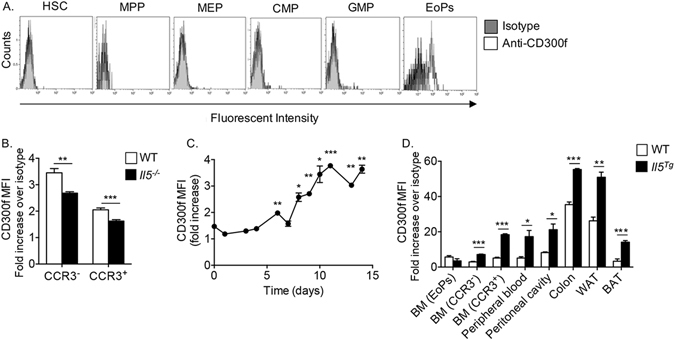Figure 1.

CD300f is expressed by eosinophil progenitors and regulated by IL-5. The expression of CD300f was assessed in bone marrow hematopoietic stem cells (HSCs, CD45+/Lin−/Sca-1−/c-kit+/CD135−), multipotent progenitors (MPPs, CD45+/Lin−/Sca-1−/c-kit+/CD135−), myeloid-erythrocyte progenitors (MEPs, CD45+/Lin−/Sca-1+/c-kit+/CD34−/CD32/16+), common myeloid progenitors (CMPs, CD45+/Lin−/Sca-1+/c-kit+/CD34+/CD32/16−), granulocyte-macrophage progenitor (GMPs, CD45+/Lin−/Sca-1+/c-kit+/CD34+/CD16+) and eosinophil progenitors (EoPs, CD45+/Lin−/Sca-1+/c-kit+/CD34int/IL-5Rα+) (A). The expression of CD300f was assessed in immature (Siglec-F+/CCR3−) and mature (Siglec-F+/CCR3+) bone marrow eosinophils in wild type (WT) and Il5 −/− mice (B). Bone marrow-derived eosinophils were generated ex-vivo and the expression of CD300f on Siglec-F+ cells was determined at the indicated time points throughout the eosinophil cell culture (C). Finally, the expression of CD300f was assessed in eosinophils (Eos) (D), from the indicated organs and in adipose tissue macrophages (Mac), monocytes (Mono) and neutrophils (Neut) (E) that were obtained from WT and hypereosinophilic Il5 transgenic (Il5 Tg) mice (D,E). In (E), the red line indicates fold-increase of 1. Data for (A) are representative of n = 5 mice, for (B), n = 6 mice, for (C), representative of 3–4 independent repeats; for (D), n = 3–4 mice; *p < 0.05, **p < 0.01, ***p < 0.001 as analyzed by Student’s t-test (B and D) and two-way ANOVA followed by Tukey post-hoc test (C).
